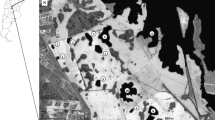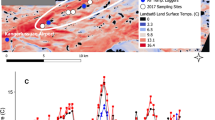Abstract
Invertebrate herbivores, insects in particular, play important functional roles in terrestrial ecosystems. At background (non-outbreak) densities, they consume 5–15 % of woody plant foliage in forests across the planet. At the same time, almost nothing is known about the levels of insect herbivory in Arctic tundra. To test the hypothesis that the amount of plant biomass lost to insects in tundra is substantially less than in subarctic forests, in 2013, we explored foliar herbivory in woody plants at three sites in the Arctic tundra and four sites in the subarctic forests of European Russia. A vast majority of foliar damage was imposed by externally feeding defoliators. In forests, defoliators damaged three times more leaves and consumed eight times more leaf area than in the tundra. No miners were found in the tundra, and gallers affected five times less leaf area in the tundra compared with forests. An abrupt decrease in loss of woody plant foliage to insects between subarctic forests and tundra (from 4.34 to 0.56 %) supports the existence of a latitudinal gradient in herbivory in terrestrial ecosystems. More studies are needed to predict how tundra plants, which have been historically exposed to low levels of insect herbivory, will cope with the increased levels of damage that are expected to occur due to climate-driven range expansion and increased abundances of plant-feeding insects.


Similar content being viewed by others
References
Alliende MC (1989) Demographic studies of a dioecious tree. II. The distribution of leaf predation within and between trees. J Ecol 77:1048–1058
Bergelson J, Fowler S, Hartley S (1986) The effects of foliage damage on casebearing moth larvae, Coleophora serratella, feeding on birch. Ecol Entomol 11:241–250
Björkman C, Berggren A, Bylund H (2011) Causes behind insect folivory patterns in latitudinal gradients. J Ecol 99:367–369
Coley PD, Aide TM (1991) Comparison of herbivory and plant defenses in temperate and tropical broad-leaved forests. In: Price PW, Lewinsohn TM, Fernandes GW, Benson WW (eds) Plant–animal interactions: evolutionary ecology in tropical and temperate regions. Wiley, New York, pp 25–49
Coley PD, Barone JA (1996) Herbivory and plant defenses in tropical forests. Ann Rev Ecol Syst 27:305–335
Danks HV (1986) Insect plant interactions in arctic regions. Rev Entomol Qué 31:52–75
Doney SC, Ruckelshaus M, Duffy JE, Barry JP, Chan F, English CA, Galindo HM, Grebmeier JM, Hollowed AB, Knowlton N, Polovina J, Rabalais NN, Sydeman WJ, Talley LD (2012) Climate change impacts on marine ecosystems. Annu Rev Mar Sci 4:11–37
Edwards PJ, Wratten SD (1983) Wound induced defenses in plants and their consequences for patterns of insect grazing. Oecologia 59:88–93
Fox LR, Morrow PA (1983) Estimates of damage by herbivorous insects on Eucalyptus trees. Aust J Ecol 8:139–147
Grime JP (2001) Plant strategies, vegetation processes, and ecosystem properties. Wiley, Chichester
Haukioja E (1981) Invertebrate herbivory at tundra sites. In: Bliss LC, Cragg JB, Heal DW, Moore JJ (eds) Tundra ecosystems: a comparative analysis. Cambridge Univ Press, Cambridge, pp 547–555
Hodkinson ID, Bird J (1998) Host-specific herbivores as sensors of climate change in Arctic and alpine environments. Arctic Alpine Res 30:78–83
Hunter MD, Reynolds BC, Hall MC, Frost CJ (2012) Effects of herbivores on ecosystem processes: the role of trait-mediated indirect effects. In: Ohgushi T, Schmitz OJ, Holt R (eds) Trait-mediated indirect interactions: ecological and evolutionary perspectives. Cambridge Univ Press, Cambridge, pp 339–370
Hunter MD, Kozlov MV, Itämies J, Pulliainen E, Bäck J, Kyrö E-M, Niemelä P (2014) Current temporal trends in moth abundance are counter to predicted effects of climate change in an assemblage of subarctic forest moths. Glob Change Biol 20:1723–1737
Kozlov MV (2008) Losses of birch foliage along geographical gradients in Northern and Central Europe: a climate-driven pattern? Clim Change 87:107–117
Kozlov MV, Zvereva EL, Zverev VE (2009) Impacts of point polluters on terrestrial biota: comparative analysis of 18 contaminated areas. Springer, Dordrecht
Kozlov MV, van Nieukerken EJ, Zverev V, Zvereva EL (2013) Abundance and diversity of birch-feeding leafminers along latitudinal gradients in Northern Europe. Ecography 36:1138–1149
Kozlov MV, Stekolshchikov A, Söderman G, Labina E, Zverev V, Zvereva EL (2015) Sap-feeding insects on forest trees along latitudinal gradients in northern Europe: a climate-driven pattern. Glob Change Biol 21:106–116
Kukal O, Dawson TE (1989) Temperature and food quality influences feeding behavior, assimilation efficiency and growth rate of arctic woolly-bear caterpillars. Oecologia 79:156–532
Legagneux P, Gauthier G, Berteaux D, Bêty J, Cadieux M-C, Bilodeau F, Bolduc E, McKinnon L, Tarroux A, Therrien JF, Morissette L, Krebs CJ (2012) Disentangling trophic relationships in a High Arctic tundra ecosystem through food web modelling. Ecology 93:1707–1716
Link H, Piepenburg D, Archambault P (2013) Are hotspots always hotspots? The relationship between diversity, resource and ecosystem functions in the Arctic. PLoS ONE 8:e74077
Lundbye H, Johansson DK, Andersen MR, Philipp M (2012) The effect of a seed-sucking bug on seed germination of an arctic cushion plant. Ecoscience 19:209–212
MacLean SF Jr, Jensen TS (1985) Food plant selection by insect herbivores in Alaskan arctic tundra: the role of plant life form. Oikos 44:211–221
Mattson WJ, Addy ND (1975) Phytophagous insects as regulators of forest primary production. Science 190:515
McNaughton SJ, Oesterheld M, Frank DA, Williams KJ (1989) Ecosystem-level patterns of primary productivity and herbivory in terrestrial habitats. Nature 341:142–144
Moles AT, Bonser SP, Poore AGB, Wallis JR, Foley WJ (2011a) Assessing the evidence for latitudinal gradients in plant defence and herbivory. Funct Ecol 25:380–388
Moles AT, Wallis IR, Foley WJ, Warton DI, Stegen JC, Bisigato AJ, Cella-Pizarro L, Clark CJ, Cohen PS, Cornwell WK, Edwards W, Ejrnæs R, Gonzales-Ojeda T, Graae BJ, Hay G, Lumbwe FC, Magaña-Rodríguez B, Moore BD, Peri PL, Poulsen JR, Veldtman R, von Zeipel H, Andrew NR, Boulter SL, Borer ET, Campón FF, Coll M, Farji-Brener AG, De Gabriel J, Jurado E, Kyhn LA, Low B, Mulder CPH, Reardon-Smith K, Rodríguez-Velázquez J, Seabloom EW, Vesk PA, van Cauter A, Waldram MS, Zheng Z, Blendinger PG, Enquist BJ, Facelli JM, Knight T, Majer JD, Martinez-Ramos M, McQuillan P, Prior LD (2011b) Putting plant resistance traits on the map: a test of the idea that plants are better defended at lower latitudes. New Phytol 191:777–788
Olofsson J, Strengbom J (2000) Response of galling invertebrates on Salix lanata to reindeer herbivory. Oikos 91:493–498
Olofsson J, Dahlgren J, Witzell J (2007) Grey-sided voles increase the susceptibility of Northern willow, Salix glauca, to invertebrate herbivory. Ecoscience 14:48–54
Olofsson J, Oksanen L, Callaghan T, Hulme PE, Oksanen T, Suominen O (2009) Herbivores inhibit climate-driven shrub expansion on the tundra. Glob Change Biol 15:2681–2693
Onoda Y, Westoby M, Adler PB, Choong AMF, Clissold FJ, Cornelissen JHC, Diaz S, Dominy NJ, Elgart A, Enrico L, Fine PVA, Howard JJ, Jalili A, Kitajima K, Kurokawa H, McArthur C, Lucas PW, Markesteijn L, Pérez-Harguindeguy N, Poorter L, Richards L, Santiago LS, Sosinski EE, Van Bael SA, Warton DI, Wright IJ, Wright SJ, Yamashita N (2011) Global patterns of leaf mechanical properties. Ecol Lett 14:301–312
Parmesan C, Ryrholm N, Stefanescu C, Hill JK, Thomas CD, Descimon H, Huntley B, Kaila L, Kullberg J, Tammaru T, Tennent WJ, Thomas JA, Warren M (1999) Poleward shifts in geographical ranges of butterfly species associated with regional warming. Nature 399:579–583
Post E, Forchhammer MC, Bret-Harte MS, Callaghan TV, Christensen TR, Elberling B, Fox AD, Gilg O, Hik DS, Høye TT, Ims RA, Jeppesen E, Klein DR, Madsen J, McGuire AD, Rysgaard S, Schindler DE, Stirling I, Tamstorf MP, Tyler NJC, van der Wal R, Welker J, Wookey PA, Schmidt NM, Aastrup P (2009) Ecological dynamics across the Arctic associated with recent climate change. Science 325:1355–1358
Roininen H, Danell K, Zinovjev A, Vikberg V, Virtanen R (2002) Community structure, survival and mortality factors in arctic populations of Eupontania leaf gallers. Polar Biol 25:605–611
Roslin T, Wirta H, Hopkins T, Hardwick B, Várkonyi G (2013) Indirect interactions in the high Arctic. PLoS ONE 8:e67367
SAS Institute (2009) SAS version 9.2 for Windows. SAS Institute, Cary
Seastedt TR, Crossley OA Jr (1984) The influence of arthropods on ecosystems. Bioscience 34:157–161
Southwood TRE, Moran VC, Kennedy CEJ (1982) The richness, abundance and biomass of the arthropod communities on trees. J Anim Ecol 51:635–649
Stien A, Ims RA, Albon SD, Fuglei E, Irvine RJ, Ropstad E, Halvorsen O, Langvatn R, Loe LE, Veiberg V, Yoccoz NG (2012) Congruent responses to weather variability in high arctic herbivores. Biol Lett 8:1002–1005
Strathdee AT, Bale JS (1998) Life on the edge: insect ecology in arctic environments. Annu Rev Entomol 43:85–106
Sturm M, Racine C, Tape K (2001) Climate change—increasing shrub abundance in the Arctic. Nature 411:546–547
Sveinbjörnsson J, Hofgaard A, Lloyd A (2002) Natural causes of the tundra-taiga boundary. Ambio Spec Rep 12:23–29
Tape K, Sturm M, Racine C (2006) The evidence for shrub expansion in Northern Alaska and the Pan-Arctic. Glob Change Biol 12:686–702
Terborgh J (1973) On the notion of favorableness in plant ecology. Am Nat 107:481–501
Torp M, Olofsson J, Witzell J, Baxter R (2010) Snow-induced changes in dwarf birch chemistry increase moth larval growth rate and level of herbivory. Polar Biol 10:693–702
Walker DA, Raynolds MK, Daniëls FJA, Einarsson E, Elvebakk A, Gould WA, Katenin AE, Kholod SS, Markon CJ, Melnikov ES, Moskalenko NG, Talbot SS, Yurtsev BA, the other members of the CAVM Team (2005) The circumpolar arctic vegetation map. J Veget Sci 16:267–282
Walther GR, Post E, Convey P, Menzel A, Parmesan C, Beebee TJC, Fromentin JM, Hoegh-Guldberg O, Bairlein F (2002) Ecological responses to recent climate change. Nature 416:389–395
Warren MS, Hill JK, Thomas JA, Asher J, Fox R, Huntley B, Roy DB, Telfer MG, Jeffcoate S, Harding P, Jeffcoate G, Willis SG, Greatorex-Davies JN, Moss D, Thomas CD (2001) Rapid responses of British butterflies to opposing forces of climate and habitat change. Nature 414:65–69
Wilgenburg E van, Elgar MA (2013) Confirmation bias in studies of nestmate recognition: a cautionary note for research into the behaviour of animals. PLoS ONE 8(1):e53548
Wookey PA, Aerts R, Bardgett RD, Baptist F, Brathen KA, Cornelissen JHC, Gough L, Hartley IP, Hopkins DW, Lavorel S, Shaver GR (2009) Ecosystem feedbacks and cascade processes: understanding their role in the responses of Arctic and alpine ecosystems to environmental change. Glob Change Biol 15:1153–1172
Zvereva EL, Kozlov MV (2000) Pollution suppresses delayed inducible resistance in boreal willow Salix borealis. Ecol Lett 3:85–89
Zvereva EL, Zverev VE, Kozlov MV (2012) Little strokes fell great oaks: minor but chronic herbivory substantially reduces birch growth. Oikos 121:2036–2043
Acknowledgments
We thank E. Yu. Churakova for help in identifying plants and E. L. Zvereva and three anonymous reviewers for commenting on an earlier draft of the manuscript. Research visits by MVK and VZ to the study sites were supported by INTERACT (Grant agreement no. 262693 under the EC 7th Framework Programme) and by the Otto Malm´’s Foundation. Fieldwork by BYF and NAZ was supported by the Ministry of Education and Science of the Russian Federation (Grant 5.4615.2011) and the Russian Foundation for the Basic Research (11-04-98814-north).
Author information
Authors and Affiliations
Corresponding author
Rights and permissions
About this article
Cite this article
Kozlov, M.V., Filippov, B.Y., Zubrij, N.A. et al. Abrupt changes in invertebrate herbivory on woody plants at the forest–tundra ecotone. Polar Biol 38, 967–974 (2015). https://doi.org/10.1007/s00300-015-1655-6
Received:
Revised:
Accepted:
Published:
Issue Date:
DOI: https://doi.org/10.1007/s00300-015-1655-6




